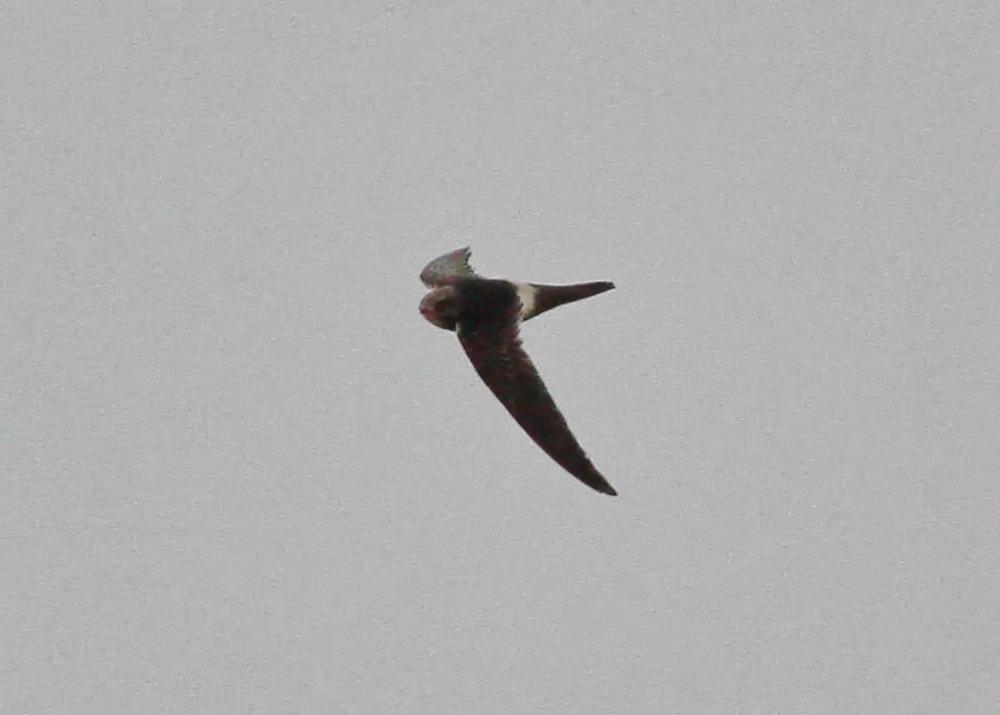Strong south-south-west winds had blown through on Saturday 13 October, so I decided it was a good idea to stay at home and concentrate on chores. My bungalow overlooks the southern end of Hornsea Mere, and as I gazed out of my window across the fields at around 3.15 pm, my view was distorted by the heavy rain and water on the window pane. Roughly 300 m away, near two ash trees, I picked up a bird which I identified as a Swallow – because of the lateness of the season I thought it may be an interesting record, so I put it on the local WhatsApp group at 3.24 pm.
I went outside to get a better view, and watched the bird as it flew towards me, heading towards the reedbed about 140 m in front of the house. At this point I noted a white rump, and I now began to wonder if it was a juvenile Red-rumped Swallow. I noted the elegant flight and moved closer to the bird as it continued to fly over the reedbed and mere edge, by which point Jon Lamplough had reported a House Martin and Swallow to the WhatsApp group.
A few minutes later, having taken in the flight style and scythe-shaped wings, I sent a message saying that I thought the bird looked more like a swift species … with a white rump! Jon phoned me and agreed to head over as quickly as possible, and with the bird temporarily disappearing, I raced home to refer to some guides. George Bennett – Wassand Estate warden – was the first to arrive and I pointed out White-rumped Swift to him in one of the guides I'd been reading.

Quick thinking from the reserve warden meant access to private land could be granted, allowing birders closer views and better photographic opportunities (Tim Jones).
The discussion about what species the bird was continued in the WhatsApp group while Jon and George relocated it independently from separate areas – they both tentatively identified it as a Pacific Swift. Aware of the sheer magnitude of such a record (or indeed any swift with a white rump) George quickly phoned BirdGuides to make sure the news could go out immediately.
It wasn't long before a throng of birders arrived, just as the weather started to clear. With multiple observers watching in far better conditions, white trailing edges to the secondaries could be made out, and consequently the consensus began to swing towards White-rumped Swift – a species never previously recorded in Britain. The bird was moving away from us towards the western end of the mere, and it became clear it was imperative that we nail the identification. This was never going to be easy with a constantly moving bird, and photos would be essential.

Photographs clinched the crucial ID feature of white trailing edges of the secondaries (Tim Jones).
However, the swift kept moving westwards towards Lady Island in the distance, and hopes of achieving pictures were rapidly diminishing. It was at this juncture that, as warden, George chose to authorise access to private land, and would seek permission retrospectively from the owner and estate manager. This decision allowed birders to move in with cameras and so photographic evidence was achieved – it was a White-rumped Swift! With my heart beating fast and my hands shaking I reported the bird on our WhatsApp group.

Despite the poor conditions, birders were able to secure the crucial photographic evidence of the White-rumped Swift (Richard Willison).
BirdGuides was informed of the new ID and the revised mega alert immediately went out. During that time a constant wave of birders arrived on site, and the bird was last seen at the western end of the mere at roughly 6.10 pm, in worsening conditions and failing light. Sadly, despite hundreds of birders being present from dawn the next day, there was no further sign of the swift.
Finding a rare bird on your patch is always exciting, but this was beyond belief, and the tricky identification and weather made for a wholly nerve-wracking moment for Hornsea Mere birders. What does it feel like to find a new bird for Britain? Absolutely amazing!

Local birders raced to the scene in order to connect with the bird. Sadly, despite hundreds of twitchers being present the following morning, the swift wasn't seen again (Jonnie Fisk).
Postscript
I'd like to give a special acknowledgment to Jon Lamplough, Jeff Cox and Mark Robinson for their quick reactions and help with identification. Furthermore, a special thank you to George for his help, allowing access to private land and for keeping BirdGuides as frequently informed as possible. Finally, thanks to Rupert Russell (estate owner) and Mike Jebson (estate manager) for allowing access.


